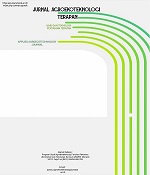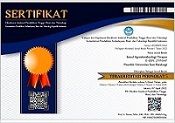The Effect Of Coconut Dregs Flour Substitution On Physicochemical And Organoleptic Properties Pukis Cake
DOI:
https://doi.org/10.35791/jat.v3i2.44337Abstract
Coconut dregs flour is flour derived from coconut dregs resulting from the process of making coconut milk or Virgin Coconut Oil. Coconut dregs flour contains high fiber and has the potential as a functional food ingredient. Pukis cake is one of the traditional snacks from Banyumas which can be processed with coconut dregs flour. The purpose of this study was to determine the appropriate formulation of cake pukis between coconut pulp flour and wheat flour (concentration 0%; 10%, 20%; 30%) which was acceptable, analyze the chemical composition, expandability and porosity. This study used Analysis of Variance (ANOVA) followed by the Least Significant Different (LSD) test with method, with α-level set at 0.05 if the treatments has a significantly effect. Analysis of variance and Least Significant Different were only used in the analysis of organoleptic and porosity. In the chemical composition test using Nutrisurvey Software. Based on the results of the test of variance, the use of coconut dregs flour has a significant effect on porosity and organoleptic color parameters. However, it does not significantly affect the scent, taste, and texture. The best concentration based on hedonic test results is 10% treatment with a development percentage of 90.47% and an average porosity value of 34.75%. According to Nutrisurvey, the nutritional content of the 10% substitution treatment contained 27.63% water, 6.43% protein, 13.27% fat, 51.91% carbohydrates, and 0.75% crude fiber.
Keywords: Coconut Dregs Flour, Pukis Cake, Physicochemical, Organoleptic
Abstrak
Tepung ampas kelapa merupakan merupakan tepung yang berasal dari ampas kelapa hasil proses pembuatan santan atau Virgin Coconut Oil. Tepung ampas kelapa mengandung serat yang tinggi dan berpotensi sebagai bahan pangan fungsional. Kue pukis adalah salah satu kudapan tradisional asal Banyumas yang dapat diolah dengan tepung ampas kelapa.
Tujuan penelitian ini adalah untuk menentukan formulasi kue pukis yang tepat antara tepung ampas kelapa dan tepung terigu (konsentrasi 0%; 10%, 20%; 30%) yang dapat diterima, menganalisis kandungan gizi, daya kembang dan porositas. Penelitian ini menggunakan analisis sidik ragam (ANOVA) yang dilanjutkan dengan uji BNT dengan taraf α = 0,05 jika perlakuan berbeda nyata. Analisis sidik ragam dan uji BNT hanya dipakai dalam analisis sifat organoleptik dan porositas. Pada uji kandungan gizi menggunakan Software Nutrisurvey. Berdasarkan hasil uji sidik ragam penggunaan tepung ampas kelapa berpengaruh nyata terhadap porositas dan organoleptik pada parameter warna. Namun tidak berperngaruh nyata terhadap aroma, rasa, dan tekstur. Konsentrasi terbaik berdasarkan hasil uji hedonik adalah perlakuan 10% dengan persentasi pengembangan 90,47% dan rata-rata nilai porositas 34,75%. Menurut Nutrisurvey, kandungan gizi perlakuan substitusi 10% memiliki kandungan air 27,63%, protein 6,43%, lemak 13,27%, karbohidrat 51,91%, dan serat kasar 0,75%.
Kata kunci: Tepung Ampas Kelapa, Kue Pukis, Fisikokimia, Organoleptik
Downloads
Published
How to Cite
Issue
Section
License
Copyright (c) 2022 Abigail Diva L. Kojansow, Tineke M. Langi, Erny J.N. Nurali

This work is licensed under a Creative Commons Attribution-NonCommercial 4.0 International License.

This work is licensed under a Creative Commons Attribution-NonCommercial 4.0 International License.




















